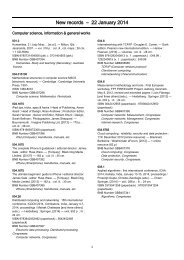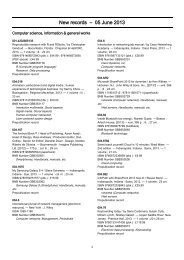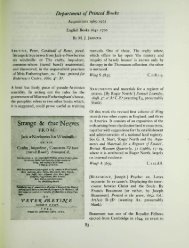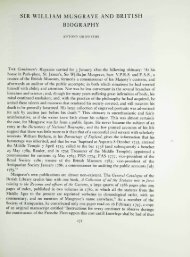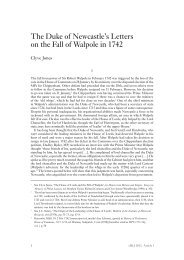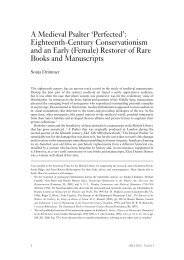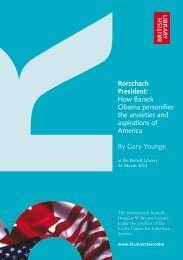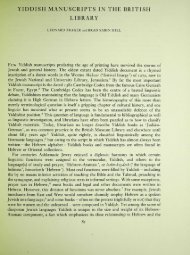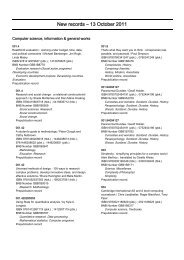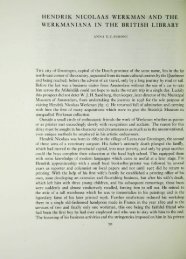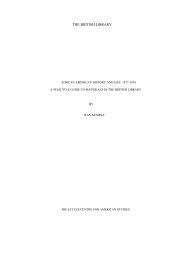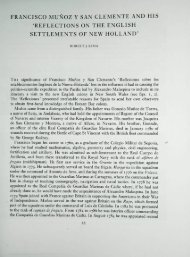Department of Printed Books: Acquisitions from the ... - British Library
Department of Printed Books: Acquisitions from the ... - British Library
Department of Printed Books: Acquisitions from the ... - British Library
Create successful ePaper yourself
Turn your PDF publications into a flip-book with our unique Google optimized e-Paper software.
The only incunable printed at Lausanne. This<br />
was <strong>the</strong> beginning <strong>of</strong> a distinguished career<br />
in printing for Jean Belot, who went <strong>from</strong><br />
Lausanne to Grenoble to settle finally in<br />
Geneva and make his fame <strong>the</strong>re. He was<br />
himself a native <strong>of</strong> Rouen; <strong>the</strong> material he used<br />
for <strong>the</strong> present Missal reflects his itinerary. The<br />
printing types derive <strong>from</strong> Paris, while <strong>the</strong><br />
woodcut was used in i486 by Guillaume le Roy<br />
in Lyon for Le Ltvre des sainctz Anges.<br />
Coptnger ^i^^.<br />
AE.R.1362. IB.38600.<br />
HOLLAND and BELGIUM<br />
GESTAROMANORUM. Gouda : Gheraert Leeu,<br />
23 August 1480. fol: 144 leaves, a-q^ r^ W^]-<br />
The Cesta Romanorum was probably compiled<br />
in England in <strong>the</strong> fourteenth century, but by <strong>the</strong><br />
later part <strong>of</strong> <strong>the</strong> fifteenth century <strong>the</strong> text was<br />
wide-spread, and was printed many times. By<br />
<strong>the</strong>n <strong>the</strong> subject matter—which later was to<br />
furnish part <strong>of</strong> <strong>the</strong> plot <strong>of</strong> Shakespeare's<br />
Merchant <strong>of</strong> Venice—was used to enliven<br />
sermons. This was also <strong>the</strong> purpose <strong>of</strong> <strong>the</strong><br />
volume that usually accompanies <strong>the</strong> present<br />
book, <strong>the</strong> Dialogus Creaturarum, printed a few<br />
months earlier at <strong>the</strong> same press. The <strong>British</strong><br />
<strong>Library</strong> copy <strong>of</strong> this book, IB.47323, which is<br />
adorned with lively woodcuts, is on permanent<br />
exhibition in <strong>the</strong> King's <strong>Library</strong>.<br />
Hatn-Copinger 282.<br />
Campbell ^2^.<br />
AE.R.2097. IB.47324.<br />
CuLTRiFicis, Engelbertus. Epistola brevis ac<br />
perutilis de symonia vitanda in recepcione<br />
noviciorum ad religionem. Nijmegen: [Printer<br />
<strong>of</strong> Engelbertus Cultrtficis, i.e. Cerardus de<br />
Leempt?], 23 August 1479. 4°: 8 leaves, <strong>the</strong><br />
last blank, a®.<br />
Two related tracts by <strong>the</strong> same author, botb<br />
written in <strong>the</strong> summer <strong>of</strong> 1479 in <strong>the</strong> Dominican<br />
monastery <strong>of</strong> Nijmegen, were <strong>the</strong> only books<br />
printed in that town during <strong>the</strong> fifteenth century.<br />
They were probably <strong>the</strong> work <strong>of</strong> <strong>the</strong><br />
95<br />
itinerant typographer Gheraert de Leempt,<br />
who was first known as one <strong>of</strong> <strong>the</strong> partners in<br />
Holland's first press at Utrecht. The most<br />
substantial <strong>of</strong> <strong>the</strong>se tracts was a treatise on <strong>the</strong><br />
rights <strong>of</strong> <strong>the</strong> mendicant order. A copy was given<br />
to <strong>the</strong> <strong>British</strong> Museum by Albert Ehrman in<br />
1948 (IA.48050). It is an extraordinary coincidence<br />
that <strong>the</strong> present book, <strong>the</strong> o<strong>the</strong>r very<br />
rare tract printed in Nijmegen, also found its<br />
way to <strong>the</strong> Broxbourne <strong>Library</strong>, and <strong>from</strong> <strong>the</strong>re<br />
to <strong>the</strong> <strong>British</strong> <strong>Library</strong>.<br />
Cesamtkatalog 7851.<br />
Campbell s^i-<br />
AE.R.638. IA.48049.<br />
AuGLiSTiNL'S, St. (Pseudo). De salute animae.<br />
Alost: [Johannes de Westfalia and Thierry<br />
Martens, c. 1473-4]. 4" (i" divided halfsheets)<br />
: 22 leaves, a^ b*^ c^.<br />
Arguments have been put forward which indicate<br />
that <strong>the</strong> present book is <strong>the</strong> first printed in<br />
<strong>the</strong> Sou<strong>the</strong>rn Ne<strong>the</strong>rlands. These were based<br />
on <strong>the</strong> paper in a number <strong>of</strong> copies (see<br />
Quaerendo, iii (1973), pp. 70-2). The present<br />
copy, which was not examined at <strong>the</strong> time,<br />
conforms to <strong>the</strong> findings <strong>of</strong> 1973.<br />
Cesamtkatalog 2962.<br />
Campbell 197.<br />
A.E.— IA.49004.<br />
LiBELLUS de modo confitendi et penitendi.<br />
Antwerp: Cheraert Leeu, 28 January 1485. 4":<br />
28 leaves, a-c® d"*.<br />
This copy <strong>of</strong> a not uncommon book bears a long<br />
contemporary note in English which shows that<br />
it was owned by a kinsman <strong>of</strong> Thomas Yard<br />
who lived in <strong>the</strong> county <strong>of</strong> Westmorland and<br />
who had severe disagreements with his mo<strong>the</strong>rin-law.<br />
For us this is evidence that <strong>the</strong> book, like<br />
so many products <strong>of</strong> <strong>the</strong> press <strong>of</strong> this Antwerp<br />
printer, was sold to England soon after completion.<br />
Of <strong>the</strong> present book <strong>the</strong>re are three o<strong>the</strong>r<br />
copies in Great Britain.<br />
Hain-Copinger 11494.<br />
Campbell 1129.<br />
AE.R.1500. IA.49735.



